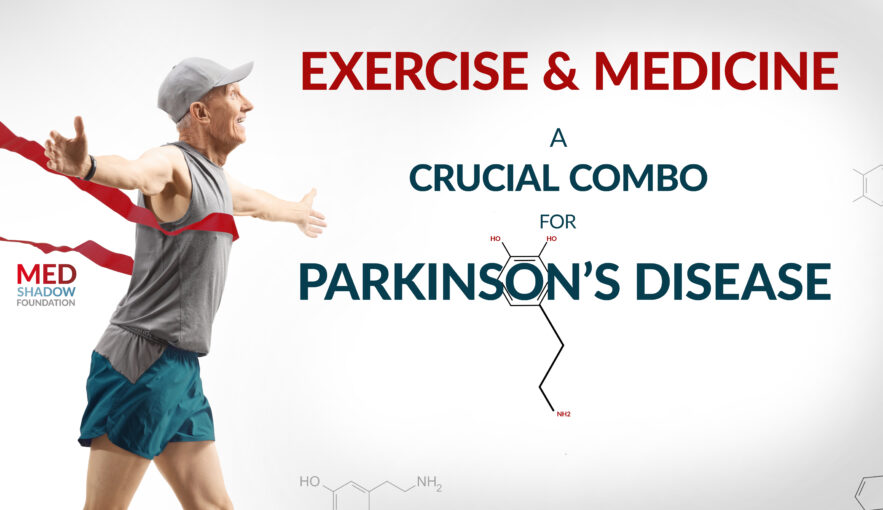Paul Molina, MD, a former radiologist who was diagnosed with Parkinson’s disease in 2016, says his physical symptoms are one-sided.
“I have a tremor in my left hand and arm. I have what’s called Bradykinesia, or slowness of movement of the entire left side of my body,” said Molina.
He says he’s also very stiff throughout the day, but he also experiences some cognitive symptoms that he says he has found to be worse.
Early in the disease process, Molina had depression and anxiety. “I actually had full-blown clinical depression following my diagnosis of Parkinson’s,” he says. The mental health challenges were “probably more debilitating” for him than his motor symptoms, he adds.
Over the past several years, Molina has worked with his doctor and made use of several resources available from patient and research organizations to help manage the disease. He’s been able to stop taking antidepressants and is much more hopeful about the future.
What Is Parkinson’s Disease?
Parkinson’s is a progressive neurological disease, meaning it gets worse over time. It starts when brain cells in the substantia nigra, a part of your brain deep between your ears, start to die. These cells make a neurotransmitter called dopamine, and when they die, you have a lot less of it in your brain. Dopamine serves many purposes in the brain, but it’s especially important for controlling movement and motivation. As the disease progresses, you may have more and more difficulty controlling movements. This is not limited to your arms and legs, it can also become difficult to control your speech and swallowing, for example.
Over time, cell death spreads outside of the substantia nigra, and can lead to more varied symptoms like cognitive decline.
Watch the Medical Animation Video About the Brain Disease Parkinson’s
Who Is at Risk for Parkinson’s Disease?
Parkinson’s is more common in men than in women and 90 to 95% of people diagnosed with Parkinson’s disease receive the diagnosis after the age of 50. Most cases are thought to be caused by an interaction between your genes and the environment, but the risks in the environment are not yet clear. Typically, by the time you’re showing symptoms and get a diagnosis, most of the cells are already dead. However, a new test may be able to identify Parkinson’s disease prior to the start of symptoms, according to a study published in The Lancet in 2023.
Is Parkinson’s Disease Hereditary?
While there are some genes that can raise your risk of developing Parkinson’s disease, it usually doesn’t run in families. Those diagnosed before the age of 50 are more likely to have inherited the gene.
Symptoms of Parkinson’s Disease
The symptoms of Parkinson’s Disease are mostly triggered by the death of neurons that make dopamine. Dopamine is involved in regulating emotions, motor control and motivation. As your body makes less dopamine, you naturally lose your ability to manage these areas.
Some of the cells in the substantia nigra, the part of the brain most affected by Parkinson’s, are connected to larger brain circuits that influence your mood and respond to other neurotransmitters like norepinephrine and serotonin. In many cases, as these cells are affected, depression actually occurs long before the motor symptoms that lead to a Parkinson’s diagnosis. Up to 50% of people with Parkinson’s also experience depression.
Often, the most noticeable symptoms of Parkinson’s are increasing difficulties with movement. While depression may precede motor symptoms, the first signal that you’re dealing with Parkinson’s and not exclusively depression, may often be a tremor or stiffness, which slows movement. Impaired balance leads to more difficulty in movement and can cause falls. Motor symptoms of Parkinson’s can include:
- Tremors
- Stiffness
- Slow movement
- Impaired balance
- Difficulty speaking and chewing
But not all of the symptoms hinder your movement. People with Parkinson’s also often experience:
- Depression
- Problems with memory and attention
- Constipation and urinary problems.
- Oily, flaky or inflamed skin, the reasons for which are not exactly clear.
For one patient, Bob McLewee, the early symptoms were mainly physical. He had a tremor on his right side, and his arm didn’t swing when he walked. Since his diagnosis in 2014, he says the little things can be the most frustrating.
“My inability to fluidly see, fasten the seatbelt in my car,” for example, said McLewee. “That’s just something I guess I have to live with.”
Does Parkinson’s Disease Cause Dementia?
Dementia, forgetfulness and Alzheimer’s-like symptoms aren’t part of the early disease process in Parkinson’s disease, but over time, as the disease progresses, and more and more brain cells in circuits that control these functions die, you may experience some of these symptoms. Many patients struggle with concentration and decision making, for example.
Many people with Parkinson’s have insomnia. Lack of sleep can make concentration difficult, as can medications that help you sleep. Depression and Parkinson’s disease also tend to go hand-in-hand, because of the overlap in neurotransmitters and brain circuits involved in each disease. Both depression and the medications used to treat it may alter your mood and attention span.
Is Parkinson’s Disease Deadly?
Parkinson’s is a progressive disease, meaning once you’re diagnosed, you will have the disease for the rest of your life and your symptoms are likely to worsen overtime. However, the disease itself is not fatal, and you can live with it for many years.
Diet for Parkinson’s Disease
Like depression, constipation can precede characteristic motor symptoms like tremors. Scientists don’t understand all of the causes of constipations in Parkinson’s, but it’s likely at least partly due to your digestive tract moving food more slowly.
Consuming foods rich in fiber and making sure you’re drinking water regularly can help move things along. Fiber-rich foods include:
- Whole grains
- Vegetables
- Fruits
- Beans and seeds
Proper hydration can also help limit confusion and balance problems. Extra exercise, Parkinson’s symptoms like excess sweating, and side effects of medications used to treat Parkinson’s (such as nausea and diarrhea) can dehydrate you, so it’s important to drink extra fluids.
Lastly, high-protein meals may prevent you from absorbing some of your medications. Consider eating lower protein meals at the time that you’re taking the drugs each day.
When Molina first started taking levodopa, he says he struggled with nausea, but taking his medication with low-protein meals helped.
Exercise Programs for Parkinson’s Disease
Because Parkinson’s disease diminishes your ability to control movements, exercise programs can be an incredibly important aspect of maintaining strength, balance, and overall quality of life. Nearly any type of exercise both slows the progression of motor symptoms and increases quality of life in Parkinson’s symptoms, according to a 2023 Cochrane Review of 156 trials including 7,939 patients.
McLewee does flexibility and balances exercises every morning, and supplements those going to the gym for workouts like cardio and weights in the afternoon.
In addition to doing his own personal cardiovascular exercise routine, Molina participates in two programs designed specifically for Parkinson’s patients: dance classes and boxing classes. Not only do the classes help him maintain his physical fitness, he credits the classes with providing a sense of community and allowing him to taper off of his antidepressant prescription.
Dance for Parkinson’s
Choreographer Mark Morris developed a program that offers free dance classes, both in person in his New York-based studio and on Zoom for people with Parkinson’s disease. The classes can be done standing or seated.
View this post on Instagram
Molina says that although he does boxing, yoga, pilates, and cardio, “the one I latched on to probably most, in terms of online, is dance programs.”
“I think the combination of movement and as importantly, the sort of socialization process of being in fairly tight knit groups online, were very helpful in alleviating many of my symptoms of depression,” said Morris. He added that “It’s one area that I felt the most out of my comfort zone, if you will. I’m not a dancer. I never had been. I lacked rhythm. But the nice thing about the dance for PD program … is that they have created and fostered such a non-judgmental environment, that people like me who are very skeptical of being able to dance are put in a very safe place. You don’t feel self-conscious, you just feel like you’re with others.”
Hear Molina talk about dance.
View this post on Instagram
Rock Steady Boxing
The Rock Steady boxing gyms are located throughout the country (find one near you). The no-contact boxing class is designed for all levels with a variety of exercises using ropes, boxing gloves, and other equipment.
The diversity helps with your coordination. Molina said he started the classes in person, but when the pandemic hit, he was glad that his coach began offering virtual classes.
“My own personal feeling, although there’s not the science to back it up, is that it’s nearly as important in terms of the non-motor symptoms as it is in terms of being beneficial for mood, depression, and anxiety,” says Molina.
Medications for Parkinson’s disease
Just about all drugs for Parkinson’s disease work to increase the amount of dopamine in your brain, as the cells that produce the neurotransmitter die due Parkinson’s disease, but they achieve this in different ways.
Levodopa-Carbidopa (Sinemet or Parcopa)
This is the most common primary treatment for Parkinson’s disease. It comes in pills you can swallow them or thin strips that dissolve on your tongue (which may be easier for those who are having difficulty swallowing). Essentially, levodopa is the precursor to dopamine. Once it crosses into your brain, your body converts it to dopamine.
Common Side Effects of Levodopa
The most common side effects of the drug are:
- Nausea
- Drowsiness
- Headaches
Molina says he was able to manage the nausea by taking his pills alongside low-protein meals.
However, in some cases patients may experience more serious cognitive effects such as:
- Hallucinations
- Confusion
- Delusions
Usually, you still start at a lower dose and gradually increase it until you find the one that works for you. If these side effects occur, contact your healthcare team who will likely need to lower your dose.
As your disease progresses, you may get to a point where the drug wears off between doses. Your physician may prescribe additional drugs to bridge this gap instead of increasing your levodopa, because it can raise the risk of side effects. Over time, some patients taking levodopa develop involuntary movements (dyskinesia) or the drug stops working as well.
Dopamine Agonists (Mirapex, Requip, Neuropro, Apokyn)
These drugs mimic dopamine and bind to the same receptors in your brain that the neurotransmitter would. They are not as effective as levodopa, but may be used in younger patients, early in the disease course, to postpone the need to use levodopa, so that drug can work longer without causing dyskinesia.
Common Side Effects
- Drowsiness
- Leg swelling
- Hallucinations
- Compulsions (discussed more below)
MAO-B Inhibitors
These drugs slow down the process through which your body breaks down dopamine, keeping it available in your brain longer. They’re not as effective as levodopa on their own but may be prescribed alongside it.
Common Side Effects
- Headache
- Nausea
- Insomnia
- Confusion, particularly in older adults
Drugs That Accompany Levodopa
COMT Inhibitors
You may be prescribed COMT (Catechol-O-methyltransferase) inhibitors, Tasmar (tolcapone), and Comtan (entacapone) if you’ve been taking levodopa for several years, and if the drug’s effects are starting to wear off between your doses. These drugs are never prescribed on their own, because their purpose is only to help prolong levodopa’s effects.
Common Side Effects
- Nausea and diarrhea
- Involuntary movements (dyskinesia)
- Hallucinations and delusions
- Orange urine
- Low blood pressure upon standing.
Anticholinergics
Anticholinergics are drugs that block a neurotransmitter called acetylcholine. This type of drug is prescribed for a variety of conditions including asthma, digestive disorders, and even motion sickness. For Parkinson’s disease, they’re used to control tremors caused by the disease. Because they have widespread activity in your body, side effects are varied.
Side effects of anticholinergics can include:
- Confusion
- Dizziness
- Rashes and hives
- Constipation
- Mouth, nose, eye and skin dryness
- Reduced sweating (which can cause you to overheat)
- Abnormal heart rhythms
- Difficulty peeing
There’s some evidence that taking anticholinergics over the long term is associated with an increased risk of dementia. Confusion as a temporary side effect is also more common among older patients taking the drugs.
Amantadine
On its own, amantadine can help improve some symptoms of Parkinson’s such as tremors and rigidity, but the effects may be temporary. More often, the drug is prescribed alongside levodopa to help reduce involuntary movements (dyskinesia) that can occur as a side effect.
Side effects of amantadine
- Confusion
- Hallucinations
- Swollen ankles
- Skin discoloration (purple blotches)
Istradefylline
Istradefylline is a newer drug, approved in 2019, also used to help extend the efficacy of levodopa when it starts to wear off. However, since it’s relatively new, researchers haven’t had sufficient time to compare it to existing options, according to UpToDate, a database and tool that provides information for doctors and patients on different treatment options.
So far, the side effects are similar to those of other Parkinson’s drugs. They include:
- Nausea or constipation
- Dizziness
- Hallucinations
- Insomnia
Deep Brain Stimulation
If your symptoms are severe, your healthcare provider may suggest deep brain stimulation. This is a surgical procedure in which a wire is implanted into the brain and attached to a pacemaker-like device that electrically stimulates neurons in the substantia nigra to help relieve symptoms and reduce your need for medication. However, like medication, while deep brain stimulation can help control symptoms, it does not slow the progression of your Parkinson’s disease.
Treatments for Non-Motor Symptoms of Parkinson’s Disease
Many people with Parkinson’s disease experience depression and insomnia. You may be treated with antidepressants or sleeping pills. Check out these MedShadow articles for information on these drugs, and tips on how to manage these symptoms without them when possible.
Coping with the Side Effects of Antidepressants
Can Yoga Help You Reduce Your Medications
Insomnia? Skip the Meds for Other Therapies Without Side Effects
Melt into Deep Sleep Using YouTube’s Meditations
Do Parkinson’s Drugs Cause Problem Gambling, Binge Eating, and Problems with Impulse Control?
After Paul Schroder was diagnosed and treated for Parkinson’s his healthcare team determined that his medication was raising his compulsion to gamble, they were able to help him control it with supervision and limited access to games, though unfortunately not before he gambled away almost $30,000.
In addition to controlling movement, dopamine, the neurotransmitter that’s depleted in Parkinson’s disease, plays a major role in the parts of the brain that respond to rewards and motivation. Since Parkinson’s drugs typically aim to increase your levels of dopamine, an unfortunate side effect can be that you struggle to control impulses, leading to excessive gambling, eating, or inappropriate sexual behaviors because your brain becomes much more sensitive to the signals telling you to repeat those behaviors.
You can read more about these experiences in MedShadow’s Drug’s for Parkinson’s: Shocking Side Effects.
Do Parkinson’s Drugs Cause Hallucinations?
Both Parkinson’s disease and the drugs commonly used to treat the disease can induce delusions, hallucinations and psychosis. Up to 50% of patients experience psychosis, typically visual hallucinations, at some point during the course of the disease.
As Parkinson’s starts to kill certain brain cells, your brain lacks dopamine. The drugs used to treat the disease correct for the neurotransmitter’s absence by raising the levels of dopamine in your brain. Unfortunately, too much dopamine can lead to hallucinations or illusions—the sense that someone is present or a distortion of your sight or hearing that is not as intense as a hallucination, but equally concerning.
In some cases, doctors may prescribe antipsychotics typically used to treat psychosis associated with disorders like schizophrenia off-label to help treat this side effect (though more than a third of Parkinson’s patients choose to stop taking these drugs after the first prescription), but in 2016, the FDA approved the first antipsychotic drug specifically designed for Parkinson’s patients, Nuplazid (pimavanserin). It’s thought to be less likely to interfere with your Parkinson’s disease treatments than other antipsychotics, which reduce the effects of dopamine.
However, within two years of the drug’s approval, nearly 700 deaths were attributed to Nuplazid. The most commonly reported adverse events were hallucinations and confusion, suggesting that the drug was ineffective in these patients. The FDA investigated, and found that most were not due to the drug. “In fact, mortality rate with Nuplazid is lower than with other antipsychotic meds and unlike others, it does not make the motor symptoms of Parkinson’s worse,” explains MedShadow Medical Advisory Board Member George Grossberg, MD, a geriatric psychiatrist.
Another strategy to reduce hallucinations that emerge as a side effect of Parkinson’s medications is, of course, to ask your doctor to lower the dose of your other Parkinson’s medications, to see if you can effectively manage your symptoms at a lower dose with fewer side effects. Read about how reducing her Parkinson’s medication helped one woman who had terrifying hallucinations of a home break-in.
Resources:
Molina recommends getting involved with several different groups that offer valuable resources, including virtual and in-person exercise programs. It’s important to note that many patient advocacy groups—including all four listed below—are supported by pharmaceutical companies. That doesn’t mean that you need to avoid their resources, just be sure to consider any conflicts of interest in medical recommendations.
Some groups supporting Parkinson’s patients include:
- Parkinson’s Foundation
- Many pharma companies are among its corporate partners.
-
- Pharma companies help develop educational content for Michael J Fox Foundation.
-
- Many pharma companies are among APDA’s corporate partners.
-
- Many pharma companies are among its corporate partners.






